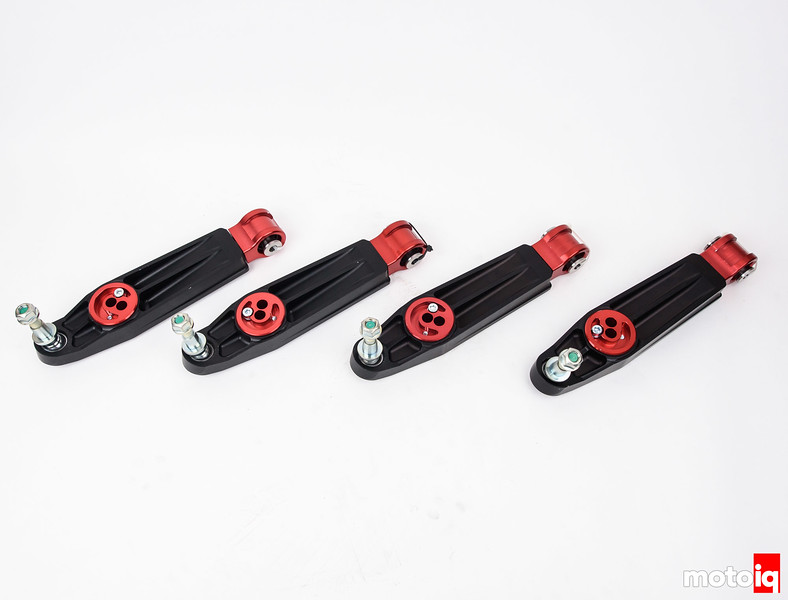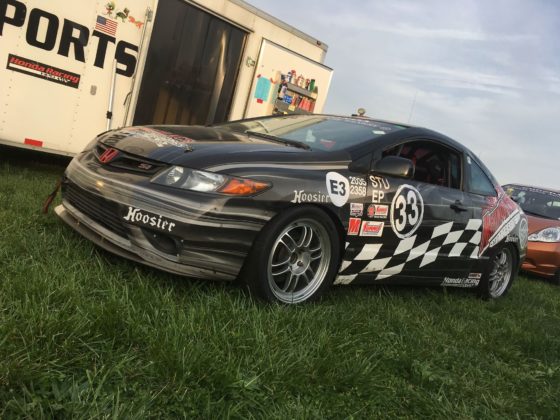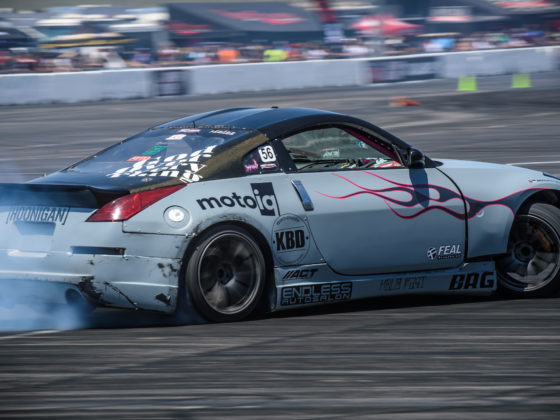
The HLS spring perch is a sealed unit that takes the place of the tender spring. As an experiment, we will be using the HLS system to allow us to rake the car so we can use it as a DRS type system on the track. Since we will be using a full flat bottom and rear diffuser on the car, the rake can make a big difference in the downforce the body can create. More to come later.

For swaybars, we choose Tarett Engineering’s adjustable racing sway bars. The front sway bar is a lightweight part that is tubular like the OEM bar. It is 26.8mm in diameter, up from the stock 24mm bar. The front bar is 5-way adjustable. The rear bar is also a hollow piece that is 19.1mm vs the stock 18.5mm in diameter. The rear bar is 4-way adjustable.

We also used Tarett Engineerings end links. The end links are adjustable in length which will help to take the bind out of the sway bars when corner weighting the car. The end links are very stiff, made out of billet aluminum with high-quality spherical bearings for the ends. There is no flex or give here.

The mounting bracket for the front Tarett bar is made for the Tarett struts which are made by JRZ. The will not work with our KW parts so we are going to have to do some minor fabrication to get them to use the stock sway bar end link mounting position.

For lower control arms, we opted to use Tarett Engineerings very trick parts. They are machined from aircraft aluminum billet and are completely adjustable.




16 comments
Ok, I really like the idea of using the HLS to do rake; will be cool if that works well. Do you know what the roll centers end up like on these things when lowered and strut inclination? I was looking at a bunch of more modern McPherson strut cars and trying to figure out what they’re doing for geometry lately.
I am waiting for the right springs to come in so I can figure stuff out and get it all set up. Next article.
Cool, looking forwards to it. I’m in the middle of some some relatively weird design work for an SCCA car so wanted to sanity check some stuff before I start machining a bunch of NLA parts; I’m basically mulling over changing steering axis inclination on 1st gen RX-7 knuckles.
Whole project is going to be going relatively slowly because I have a one month old daughter now, but I figure if I’m going to the extent of having shock pistons made for struts and doing cambered floater hubs on a live axle, might as well be thorough.
You can look to off road and circle track parts for camber floating live axle hubs. Some Mustang guys run that stuff on drift cars too. I am in the middle of figuring out how to control scrub on a strut suspension with really wide tires. My first idea got banned by FD before we could even make it.
I’m cribbing design of it from circle track practice certainly, but scaling down – the circle track stuff with the right features all tends to be 5×5″ bolt pattern and all the affordable good 15×7 wheels (yay SCCA rules) are 4x100mm.
I assume you’ve seen the Revoknuckle, Superstrut, and the dual pivot lower control arm solutions… I’ve been thinking of the same thing and how to get something like that through the rules. Only about 9.5″ of tread width, but on slicks, and I’m not sure power steering is in the weight budget.
What about something like the Chevy Cruze WTCC front strut – they had a big bracket moving the strut around the tire which could let you sink the knuckle deeper into the wheel.
“The anti-corrosive construction is one of the reasons why KW Clubsports have a limited lifetime guarantee.” The KW Clubsports do not carry a warranty as stated by KW’s web site, unlike the other models. Unless you’re referring to another guarantee, thought I’d point that out for those in the market.
Nice program !
I like the pinch bolts instead of jam nuts to lock the alignement settings ! Far more convenient and precise.
The Rennline brace doesn’t look that well engineered though, it’s more for show than actual stiffness.
I’ve had a really good result with tightening the front end with a triangle brace on the front subframe, where there is usually just two stamped steel braces, I have a solid piece that triangulates the whole subframe instead and the difference is quite noticeable ! Should be even more so with full spherical bearings suspensions !
Did you fabricate the brace or is it commercially available?
It’s a Ultra Racing brace. I’m sure you can easily fabricate one like it. But it was very cheap.
It protrudes a bit underneath the car, but no big deal on mine, it never touched anything (and I’m lowered).
Check out their strut brace too, looks much stronger than the rennline 😉
I’ve been running Tarett parts for 15+ years on my aircooled cars, top notch stuff that is built to last. We recently added the Tarett cockpit adjustable sway bars to our 987.1 Cayman racecar and they are awesome too. It’s so nice to be able to make adjustments on the fly without losing time on track or having to roll around on 100+ degree asphalt between sessions.
We agree and that’s why we chose them as well!
Is this project still going on, I’m building up my 2009 Cayman S and looking for ideas.
So far I have JRZ RS’s front and rear, Tarett lower control arms front and camber plates up top. Rennline tie-downs and rear support. Adjustable Rear toe links and I have a Tarett 22mm rear anti-swaybar and adjustable swaybar links.
My car is a PDK and I live in Arizona so I just had a BGB transmission cooler installed. Next, I have Sparco EVO race seats and harness bar going in as soon as I get my BBI mounting brackets, any day now.
It’s an ongoing prosses so I’d like to see how this build is going.
We are about to do a bunch of engine and cooling stuff.
Mike, Two of us own a 987.2 and are about to embark on suspension upgrades. We are both instructors with BMW and PCA and Audi. We have stock suspension, albeit low mileage car. 18″ wheels and 200 R comp type tires. We have experienced understeer, wheel hop and lack of ease to slip angle the car and get on throttle. As we research we are leaning to the Tarett and have watched your video on the suspension work you did on the 987.2. We are wondering if the work you did to lower the tension/thrust arms, etc. (to reduce anti dive and anti squat) actually worked to reduce hop? Stephan and Zafer
Billy Johnson tested the car at Buttonwillow and he did not complain about wheel hop, there is an aero imbalance that we need to fix. that was causing understeer. Billy said the back of the car was very planted. It was turning 1:57 laps which is ok for the type of tires. I think the car has another 2 seconds in it easily with some more suspension and aero tuning. I was not there that day and I could have worked it better working with Billy.